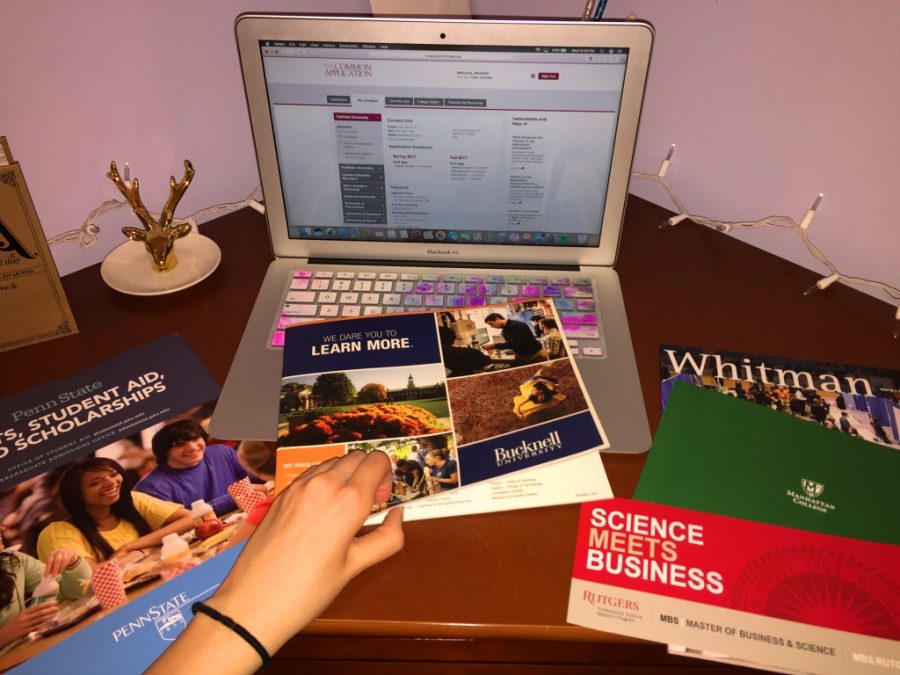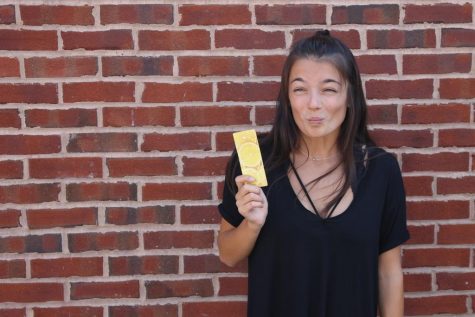College application influx raises challenge to stand out
February 8, 2017
An envelope with a college’s name is unassumingly on a table. Is it the right size for an acceptance? Is it heavy enough? Only one way to find out —
For many seniors, the letters and emails they receive in the upcoming months will determine their futures for the next four years. But seniors of Glen Rock High School are not the only ones impatiently refreshing their emails ten times per day, nor are they alone in meticulously sifting through the envelopes they receive in the mail every afternoon. Nationwide, more seniors than ever before are waiting to hear from colleges, and they are experiencing more anxiety than ever before as well.
According to a State College Admissions Report, “Growth in Application Volume Continues: Between the Fall 2014 and Fall 2015 admission cycles, the number of applications from first-time freshmen increased 6 percent…and international student applications increased by 23 percent, on average.”
This trend is troubling for those involved with the college admissions process at the high school.
“The Common App has made it easier to apply to more colleges, more students such as first generation are attending college, and students are applying to more colleges to “beat the odds” because of the selectivity of some of these schools,” guidance counselor Rochelle Eaton said.
Sources outside the guidance department partially accredit The Common App with this spike in applications as well. This online application for colleges allows students to select as many colleges as they want to add to their virtual “mailing” list. Once the applicant fills out a communal form, they select an essay prompt and respond in 250-650 words. Some colleges request additional writing samples. All of this can be submitted via just one webpage.
According to Ms. Claire Cafaro, who works as an independent college counselor, “The Common Application is always cited as the main reason” for the bump in applications.
Cafaro supplements the work of guidance counselors employed by high schools in the area. She left the Ridgewood school district 10 years ago, but she has continued to navigate the college applications process with high schoolers ever since. As a college admissions consultant at Clear Directions of HoHoKus, Cafaro’s main objective is to more deeply investigate the schools her clients are interested in, and act as a support network throughout the hectic process.
“Students who are applying to the most selective schools are applying to more schools and think that it will help their chances. They feel like it will give them schools to fall back on and ensure they will have a variety of schools to choose from when deciding where to attend in the fall,” Cafaro said of her clients.
While the national average of applications sent out via Common App are 5.5 schools per applicant, some Glen Rock High School students may send out double that number.
“Students will apply to about 8-12 colleges each. That number has been consistent for the past six years,” Eaton said.
This is not only a tedious job for the applicant, but for the admissions office at these universities as well. Across the country, UCLA’s applicant pool reached six figures this year, as UCLA Newsroom released that they received over 102,000 applications from the incoming class of 2021.
Due to this influx of applications, community work, the essay and recommendations are becoming increasingly significant, while they are more subjective, or unpredictable factors in the decision making process.
“Most applicants are fully qualified with grades and extracurriculars. Colleges may be looking at these softer qualifications. The admissions office is looking at the class or community that they are building,” Cafaro said.
This shift is particularly prevalent in the Northeast.
“Colleges are becoming more selective because of an increase in applications. More so if the school is within the 3-4 hour radius,” Eaton said.
Just an hour or so away from Glen Rock, Princeton University’s early action pool increased by 18.3% since just last year, making it their largest applicant base in six years. A lengthy list of colleges is recommended by counselors, who suggest striving for a list that mimics the 2:4:2 ratio: 2 reach schools, 4 target schools and 2 safety schools. But where should students draw the line?
“They fly to a bunch of schools without having done their research,” Cafaro said. While some students may not be seeking out enough information about the schools they are applying to, perhaps a lack of information isn’t always the problem. The advertisements flooding high school students’ mailboxes and email inboxes could be a trap that many are falling right into.
“Colleges spend so much money marketing themselves. They want to grow their applicant pool because then they look more selective,” Cafaro said. But colleges aren’t the only ones doling out the cash in attempt to better their chances. Expansive lists can come with substantial price tags.
In 2015 “the average application fee was $41, according to the 1,068 ranked colleges reporting data to U.S. News in spring 2015. Among these schools, the most common fee charged was $50,” according to U.S. News.
Some schools, such as Syracuse University and University of Delaware charged $75 per application, and Stanford University in California was ranked most expensive college to apply to, charging $90 per application.
“In the end I applied to 11 schools. In total, I probably spent five hundred dollars,” a senior Glen Rock student said.
In order to hone in extensive college lists, Cafaro suggests that students keep two things at mind as they work through the rigorous process: Be open to both names that “aren’t as familiar to them” and outside their own “area” geographically. Eaton offers similar advice.
“We encourage students to look outside of the ten ‘typical’ schools that Glen Rock students apply to,” Eaton said.




